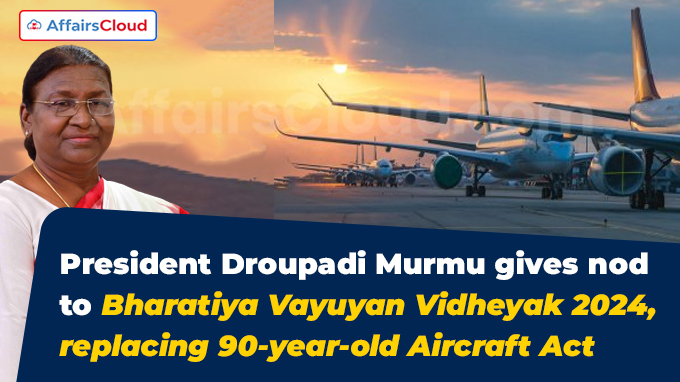 In December 2024, the President of India, Droupadi Murmu granted assent to the Bharatiya Vayuyan Vidheyak (BVV) 2024, which replaced the colonial-era (90-year-old) Aircraft Act of 1934.
In December 2024, the President of India, Droupadi Murmu granted assent to the Bharatiya Vayuyan Vidheyak (BVV) 2024, which replaced the colonial-era (90-year-old) Aircraft Act of 1934.
- The notification was issued by the Ministry of Law and Justice (MoL&J) following the bill’s passage in both Houses of Parliament, Rajya Sabha (Council of States) and the Lok Sabha(House of the People).
- The primary aim is to enhance safety, streamline regulatory processes and improve aviation security and infrastructure management in India.
Points to Note:
i.In India, the civil aviation sector is primarily governed by two key laws:
- The Aircraft Act, 1934: Regulates various activities related to civil aviation, including airport licensing.It has been amended 21 times.
- The Airports Economic Regulatory Authority of India (AERA) Act, 2008: Regulate tariffs and monitor airports performance standards.
ii.The legislation seeks to remove redundancies and replace the Aircraft Act 1934, which has been amended 21 times over 9 decades.
About Bharatiya Vayuyan Vidheyak(BVV) 2024:
i.The BVV 2024, introduced in July 2024 and passed in August 2024 by Lok Sabha, aims to modernize India’s aviation regulatory framework, eliminate redundancies and enhance ease of doing business in the sector.
- The Bill seeks to replace the Aircraft Act, 1934 but retains most of the provisions of the Act.
ii.Amendment and New Legislative Developments:In 2020, the Aircraft Act was amended to grant statutory recognition to 3 critical bodies:
- Directorate General of Civil Aviation (DGCA) for regulatory functions and safety oversight.
- Bureau of Civil Aviation Security (BCAS) for security purposes.
- Aircraft Accidents Investigation Bureau (AAIB) for accident investigations.
Key Features:
i.Authorities:The new Bill sets up 3 authorities including Directorate General of Civil Aviation (DGCA), Bureau of Civil Aviation Security (BCAS), and Aircraft Accidents Investigation Bureau (AAIB), with the central government of India (GoI) overseeing them.
- It adds the provision that appeals against orders of DGCA or BCAS will be directed to the central government, with no further appeals allowed.
- The Bill empowers the DGCA to regulate not only the manufacture, repair, and maintenance of aircraft but also the design and locations where aircraft are being designed.
ii.Regulation of design of aircraft: The Act regulates activities related to aircrafts including manufacturing, use, operation and trade.
- The Bill also empowers to regulate aircraft design and establishes rules for radio telephone operator certificates.
- The bill transfer the responsibility for managing Radio Telephone Operator Restricted (RTR) certifications from the Department of Telecom (DoT) under the Ministry of Communications(MoC) to the DGCA.
iii.Penalties: The Bill outlines significant penalties for violations such as illegal carriage of prohibited goods and failure to comply with aviation rules.
- Penalties include imprisonment up to 2 years, a fine of up to 1 crore rupees or both.
iv.Powers to make Rules:The Act empowers the central government to make Rules on matters including:
- Regulation of specified activities related to aircrafts and matters on licencing, certification, and inspection.
- Regulation of air transport services.
- Implementation of Convention on International Civil Aviation, 1944.
v.Adjudication of penalties: The Act empowers the central government to appoint an officer for adjudication of penalties.This officer must be of the rank of the Deputy Secretary to Government of India or above.
- Decisions of the Adjudicating Officer may be appealed before an Appellate Officer, who must be of a higher rank than the Adjudicating Officer.
- The Bill retains this and adds an additional level of appeal.
- The appeal against the decisions of the First Appellate Officer will lie before the Second Appellate Officer.
- The Second Appellate Officer must be an officer of a higher rank than the First Appellate Officer.
Note: Indian carriers added 112 new aircraft in 2023, bringing the total to 771 planes, with plans to reach 1,100 by 2027.




